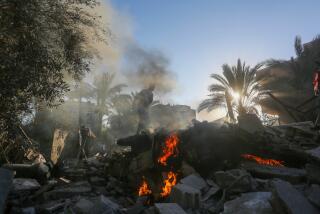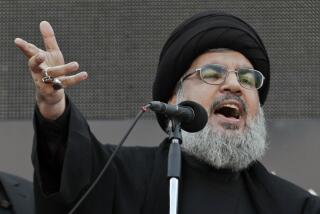‘Martyrs’ Leading War on Israel
BETHLEHEM, West Bank — Ibrahim Abeiyat started his day by ordering the killing of a Jewish settler. Around noon, he moved about town openly, if carefully, gathering intelligence and procuring weapons. After nightfall, he hunkered down with his men while Israeli warplanes bombarded Bethlehem’s main police headquarters.
As a local commander of the Al Aqsa Martyrs Brigade, Abeiyat is one of scores of guerrilla fighters who have assumed the lead in the war Palestinians are waging against Israel.
The majority of recent deadly attacks on Israeli soldiers and civilians--and some of the most brazen--have been carried out by the Al Aqsa brigade, an underground militia affiliated with the Fatah movement of Palestinian Authority President Yasser Arafat.
The Palestinian operations--along with a massive Israeli military offensive--have helped fuel a stunning escalation in bloodletting that has claimed more than 1,200 lives in 17 months. Palestinians and Israelis are attacking and counterattacking at a dizzying pace, and both sides have threatened more.
“We will hit the Israelis where it hurts the most,” Abeiyat said in an interview.
Abeiyat and his comrades began using the name Al Aqsa Martyrs Brigade a few weeks after the current conflict erupted in September 2000. Al Aqsa is the revered mosque in Jerusalem where the fighting began after Ariel Sharon, now Israel’s prime minister, and a small army of police entered the compound where the mosque is located. The compound is considered holy by Jews and Muslims, and Muslims saw Sharon’s visit as sacrilege.
“So many people were being killed, there was a need to stand up and take revenge,” said Abeiyat, 29.
At first, the Al Aqsa brigade focused its attacks within the West Bank and Gaza Strip, targeting symbols of occupation: military roadblocks and Jewish settlers. Later, however, as the militia’s ranks evidently swelled, civilians within Israel proper were added to the list of targets.
Today, the Al Aqsa brigade includes coolheaded snipers, guerrilla commandos, suicide bombers and even a unit of female fighters--the only one in this conflict.
The “brigade” is in fact numerous cells formed locally in towns and refugee camps across the West Bank and Gaza Strip. There appears to be little operational coordination among the cells, but members share nominal allegiance--though not total obedience--to the Fatah leadership. Brigade members are less willing than Fatah to compromise for peace with Israel.
The Al Aqsa brigade is an offshoot of the Tanzim, Fatah’s armed wing. Arafat created the Tanzim in 1995 as a counterbalance to the growing power of the military wings of radical Islamic groups.
Most of the Al Aqsa guerrillas cut their teeth in the first intifada, the six-year uprising against Israeli military occupation that ended in 1993 with the advent of the Oslo peace process. And many were further hardened in Israeli jails.
Later, after the Palestinian Authority was formed and given control of part of the West Bank and Gaza Strip, many joined the Palestinian police and security forces, which received training and equipment from U.S. and European advisors.
The superior training and availability of weapons gave them an edge in guerrilla tactics over the extremist Islamic groups that, until recently, had carried out nearly all of the suicide bombing attacks.
By one Israeli analyst’s count, the militant Islamic movement Hamas carried out 100 attacks in 2001 and Fatah militias 80; in the first 60 days of this year, Fatah had carried out 51, Hamas 10.
In their operations, the Al Aqsa guerrillas hope to restore Fatah’s popularity, which had slipped in relation to Hamas in recent months. But the surging activity of Fatah militias poses a political problem for Arafat. He cannot claim the same distance from these armed groups as he has from the Islamic factions--and in fact benefits domestically as Fatah gains strength. But he has shown no inclination to rein them in--something that would be difficult given the decentralized character of the Al Aqsa cadres.
Nasser abu Hmeid is an especially popular militia commander in the West Bank city of Ramallah. He said that although most members are Fatah, the group doesn’t consider itself committed to the same international agreements and treaties--namely, the Oslo peace accords--that Arafat signed.
“We are a military wing,” he said, “and we do not want to be obligated to any political line.”
Hmeid, 30, spent 14 years in an Israeli prison, serving nine life sentences for the slaying of 10 Palestinians he suspected of having collaborated with Israel. He was freed in 1999 as part of a prisoner-release deal and worked in the Palestinian Authority’s Ministry for Prisoner Affairs until the current uprising.
He made a semipublic appearance in Ramallah this week at the funeral for an Al Aqsa commander who was killed when an Israeli helicopter fired a missile into his car. Abu Hmeid and most other militia chiefs assume that they are on Israel’s hit list. Israel holds them responsible for the deaths of scores of its citizens.
As the funeral procession geared up and shouts of “Allahu akbar!” (God is great!) rang out, Abu Hmeid kept to the sidelines. He sat cross-legged on the ground under a cypress tree, an M-16 on his lap, five bodyguards arrayed in a semicircle behind him.
Both Abu Hmeid, in Ramallah, and Abeiyat, in Bethlehem, defended the decision of some members of the organization to target civilians, including children, in Jerusalem or Tel Aviv, even though the official Fatah line is to restrict attacks to the West Bank and Gaza.
“As long as Israel keeps hitting our civilians, we have no choice but to go after their civilians,” Abu Hmeid said.
Ibrahim Hassouna, a 21-year-old officer in the Palestinian navy, joined the Al Aqsa brigade in the hard-line West Bank city of Nablus. On Tuesday, Hassouna charged into an upscale restaurant in Tel Aviv, guns ablaze. He killed three Israelis before being shot dead by a policeman, who was himself mortally wounded.
Al Aqsa claimed credit for the first two female suicide bombers in the uprising. One, Dareen abu Aisheh, had belonged to Hamas, but when the Islamic fundamentalists wouldn’t let a woman do the job, she switched to Al Aqsa.
Al Aqsa also claimed responsibility when a resident of the Dahaisha refugee camp outside Bethlehem, Mohammed Daraghma, waded into a crowd of women and children in an ultra-Orthodox Jewish neighborhood of Jerusalem and detonated a powerful bomb strapped to his body. He and 10 Israelis, including two infants and other children, were killed.
Abeiyat said Daraghma was acting out of rage and depression over the shooting death of his best friend, killed by Israeli soldiers in a clash at Rachel’s Tomb in Bethlehem. Abeiyat said that it wasn’t the kind of operation he prefers but that he recognizes it as part of the struggle.
Abeiyat acknowledged ordering the shooting of settlers this week on a road that skirts Bethlehem. On Tuesday, Dvora Friedman was killed and her husband injured. Abeiyat said the shooting was in retaliation for Israel’s repeated bombardment of a security complex in central Bethlehem.
Abeiyat, who comes from a large, rough clan that lives on the rural eastern edge of Bethlehem, joined Fatah at 15, was in jail by the time he was 17 and took up guns against Israel when he joined the Al Aqsa brigade.
He was interviewed in a souvenir shop on Bethlehem’s Manger Square, across from the Church of the Nativity. Abeiyat wore black, the unofficial uniform of the Al Aqsa brigade, a Belgian-made Browning pistol on his hip. He spoke occasionally into a red cellular phone and smoked steadily. His bodyguard was armed with an AK-47.
Abeiyat became a commander after succeeding one cousin, Atef, who was killed in an Israeli assassination in October. Israel blamed Atef for several slayings of settlers. Atef had succeeded another cousin, Hussein, who was killed by Israel in November 2000. Hussein is considered the first target of Israel’s controversial assassination policy, in which Israeli forces hunt down and kill suspected militants.
As horrific as the suicide bombings are, it is a string of attacks on the army that has most unnerved Israel’s military establishment.
Reflecting a gradual sophistication in Palestinian tactics, cadres of the Al Aqsa brigade have repeatedly attacked Israeli military roadblocks in the West Bank and Gaza Strip, some of which are isolated and exposed.
Six soldiers were killed in one such raid, and seven more soldiers and three settlers in another 12 days later. In both, the assailants escaped, apparently unscathed. Three tank crewmen were killed in an ambush on an Israeli Merkava tank in the Gaza Strip last month, also attributed to the Al Aqsa brigade.
Most of the attacks came in response to Israel’s incursions into two refugee camps, members of the brigade said. Israeli operations, they said, are fueling more and more Palestinian resistance.
“We are gaining experience in military activities by the day,” said Maged Masri, another Al Aqsa commander based at the Balata refugee camp in the West Bank city of Nablus. The camp was raided by Israeli forces last week. Masri is a former police officer who said he’s been armed and ready to fight since well before the current uprising.
“We had dozens of martyrdom fighters [those who will carry out suicide attacks] before,” he said from the Balata camp, where he and other gunmen returned once the Israelis pulled out. “But now they are in the hundreds and thousands.”
More to Read
Sign up for Essential California
The most important California stories and recommendations in your inbox every morning.
You may occasionally receive promotional content from the Los Angeles Times.











